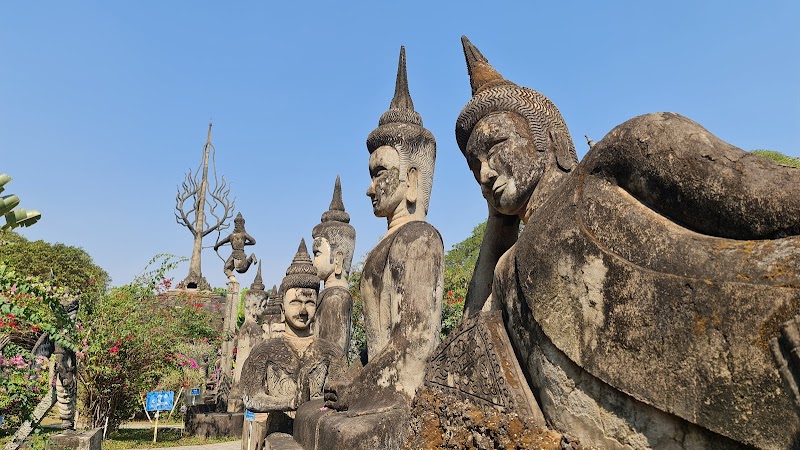
That Luang Festival in Vientiane is a powerful celebration of faith and culture around Laos's most iconic golden stupa. Experience vibrant processions, local traditions, and spiritual ceremonies while preparing for the bustling, humid atmosphere with practical tips to navigate the event.
Wear Comfortable, Non-Slip Footwear
Temple grounds get wet and slippery, especially at dawn and dusk. Shoes with good traction help you navigate safely through crowds and uneven surfaces.
Stay Hydrated Throughout the Day
Humidity combined with walking and standing for hours demands regular water intake. Carry a refillable water bottle to avoid dehydration.
Arrive Early for Best Views
The festival draws large crowds. Early mornings provide more space and clearer perspectives of the golden stupa and ceremonies.
Respect Local Customs and Sacred Spaces
Photography and behavior guidelines are strictly observed near religious areas. Modest dress and mindful conduct enhance your experience.
That Luang Festival: Vientiane’s Vibrant Journey of Faith and Tradition
Every November, Vientiane pulses with life as the That Luang Festival unfolds around the golden stupa of Pha That Luang. This event isn’t just a gathering; it’s a dynamic experience where history, culture, and spiritual energy collide in a vivid display of devotion and celebration. The festival's grounds swell with locals and travelers weaving through colorful processions, illuminated offerings, and traditional Lao music that insistently invites participation.
Staring up at the golden spire piercing the sky, you sense its fierce presence—fiercely itself—a force that has defined Laos’s identity for centuries. The festival marks the culmination of Buddhist Lent, and visitors witness candlelit parades following monks through the temple grounds. The air carries the hum of chants and the scent of incense that dares you to pause and reflect.
Planning your visit to That Luang Festival means navigating both the spectacle and the practicalities. The festival spans about three days, making early arrival advisable to secure accommodations in Vientiane, the city just steps from the event. Expect large crowds and a festive hustle, but also structured areas for meditation and prayer if you seek quieter moments.
Mornings offer the clearest views of the stupa under crisp daylight, while dusk transforms the site into a glowing beacon against the darkening sky. Footwear choice matters; the temple grounds can become slick with morning dew or evening rain, so sturdy shoes with good grip are essential. Hydration is critical—humidity clings to the air, challenging even the most seasoned traveler.
Vendors line the streets offering local Lao fare, from spicy papaya salad to sticky rice wrapped in banana leaves—a practical chance to fuel up during long festival hours. While navigating crowds, keep essentials like a refillable water bottle and sun protection within reach.
Engaging with That Luang Festival is more than observing; it’s moving with the crowd, learning the rhythms of offerings and appreciating how the festival fiercely upholds heritage. Respect for local customs and eagerness to immerse yourself without overwhelming the sacred site enriches the experience.
Beyond the festival perimeter, Vientiane offers a comfortable base with laid-back cafés and quiet parks where you can decompress. This is an event where adventure meets mindfulness, guided by a culture deeply rooted in belief and community. That Luang Festival commands respect and rewards those prepared to meet it on its own terms.
Nearby Trips
All Adventures
Boat Charters
Water Activities
Adventures near Vientiane
Discover the unique and memorable adventures that make Vientiane special.
Frequently Asked Questions
What is the significance of That Luang Festival?
That Luang Festival celebrates the end of Buddhist Lent and honors the Pha That Luang stupa, believed to enshrine a relic of the Buddha. It reflects Laos’s spiritual heritage through rituals, offerings, and processions.
How crowded does the festival get, and how can I navigate it?
The festival attracts thousands daily, making the core areas dense with people. Arrive early or late in the day to avoid peak crowds and stay aware of your belongings while moving through the festival grounds.
Are there any restrictions on photography?
Photography is allowed in most public areas, but some religious ceremonies and temple interiors prohibit cameras out of respect. Always ask before shooting close-ups of monks or worshippers.
What local foods should I try while attending the festival?
Try traditional Lao dishes such as khao niaw (sticky rice), larb (spicy minced meat salad), and tam mak hoong (papaya salad) offered by street vendors and food stalls around the festival.
Is That Luang Festival accessible for travelers with limited mobility?
While much of the event is outdoors and on paved paths, large crowds and uneven temple grounds might pose challenges. Assistance and resting areas are available, but planning ahead and avoiding peak times helps improve accessibility.
What local wildlife might I encounter near the festival area?
While the festival site is urban, occasionally monitor lizards and colorful birds like mynas can be seen near the temple grounds. In surrounding city parks, you may spot kingfishers and butterflies.
Recommended Gear
Comfortable Walking Shoes
Durable with good grip to handle wet temple floors and long hours on foot.
Reusable Water Bottle
Hydrate frequently to counteract humid conditions, especially during long ceremonies.
Lightweight, Modest Clothing
Cover shoulders and knees to respect religious customs while staying cool.
Portable Umbrella or Rain Poncho
Useful for sudden monsoon showers or shading against strong sun.
Local Insights
Hidden Gems
- "Phra That Luang’s less-visited back corner for quiet reflection"
- "Nearby Wat Si Saket with its historic Buddha niches"
Wildlife
- "Monitor lizards sunning near temple gardens"
- "Urban birdlife such as mynas and egrets"
History
"Pha That Luang was originally built in the 3rd century and rebuilt multiple times, serving as a national symbol of Lao sovereignty and Buddhist faith. The festival has roots in both animist and Buddhist traditions, blending secular and spiritual Laotian culture."
